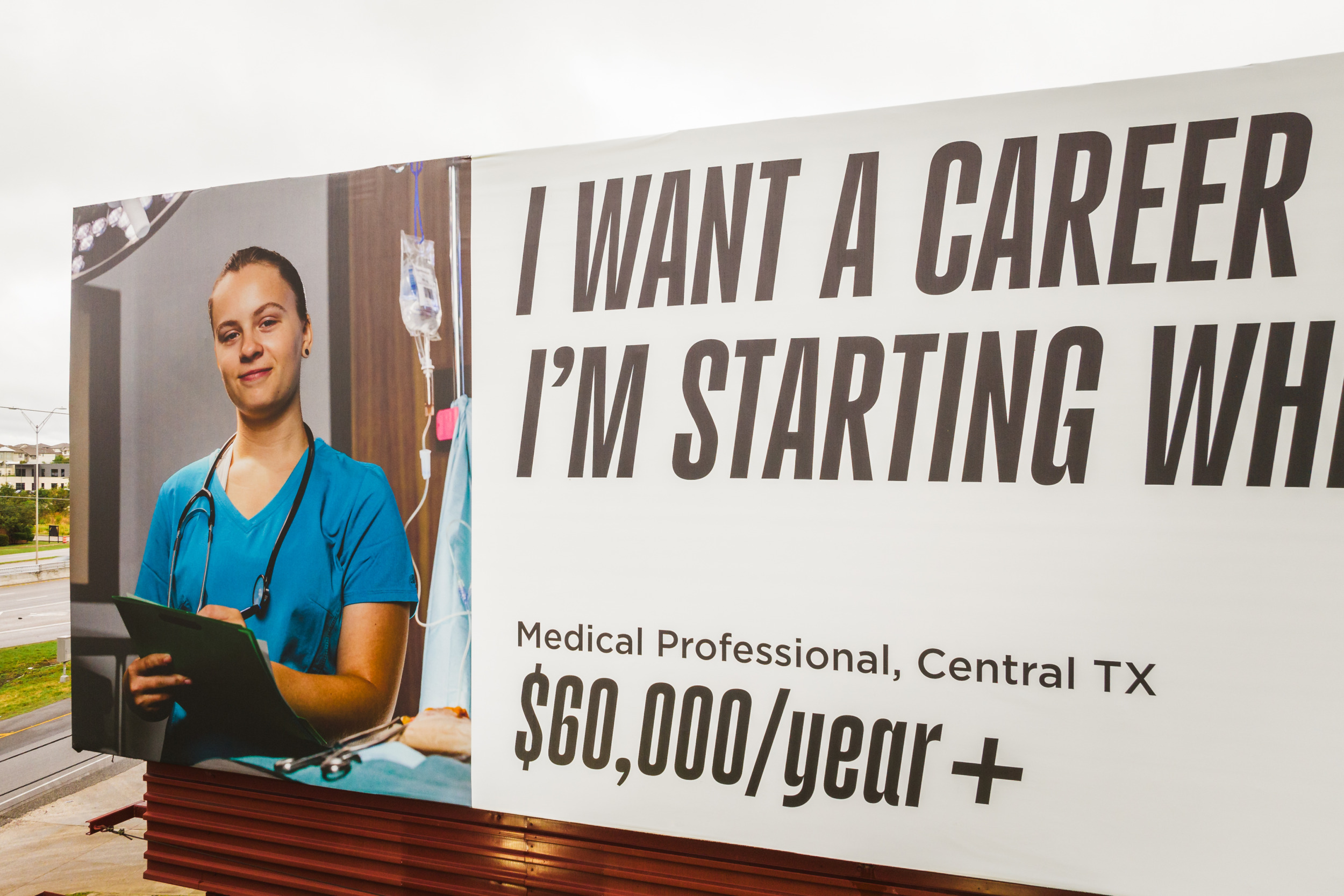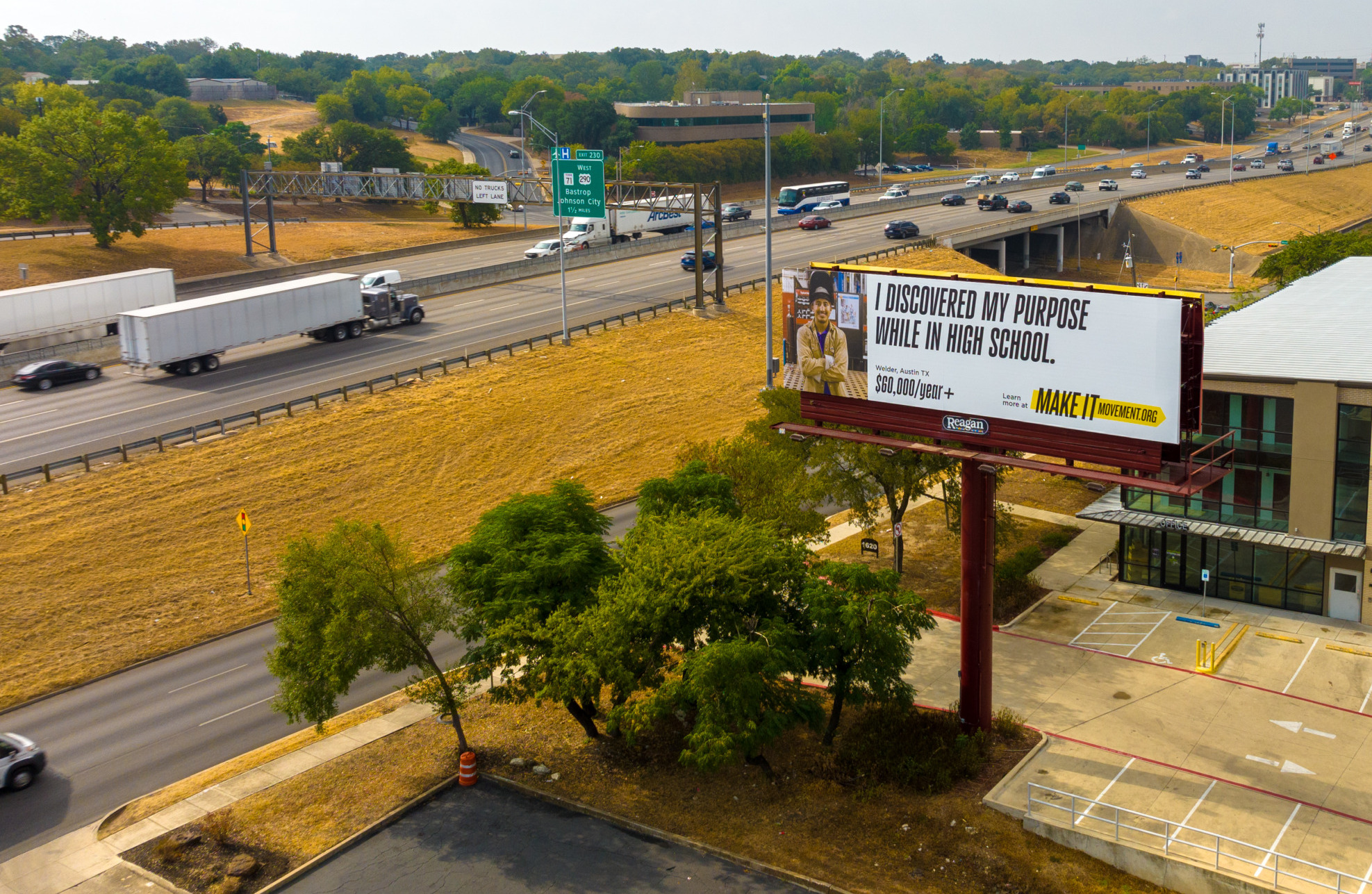This story was produced by The Hechinger Report, a nonprofit, nonpartisan news outlet focused on education.
Aléshah Brown wasn’t yet in high school when she started having doubts about college.
“Even in middle school, you’re feeling all this pressure and stress about going to college, but no one’s asking you, ‘What do you want to do?’ ” said Brown, of San Antonio, Texas. “That was a very stressful thing for me.”
This anxiety, along with the cost and other issues, is among the many things discouraging growing numbers of students from even applying to college.
Brown eventually found a website that promised, in plain and simple English, to help her start her journey. Much of the information was conveyed by other young people who had already graduated from high school and begun careers. And the site prominently included how much money she could make in particular jobs.
“It’s showing students, ‘Hey, let’s see what you individually like to do, what you love and how you can make a difference in the world,’ ” she said. “You’re being asked that question instead of being given this general list of options that you don’t understand.
How an adman is confronting the crisis of confidence higher education isn’t doing much about
This clear-cut, straightforward message didn’t come from academics or administrators, policymakers or politicians. It’s the brainchild of an advertising executive, Roy Spence, the man behind such well-known slogans as “Don’t Mess With Texas” and “You are now free to move about the country.”
Spence’s campaign underscores how glaringly little the higher education industry itself has done to confront the crisis of confidence that is eating away at its business.
“Universities tend to have a hard time having a very clear, focused message,” said Eunkyu Lee, associate dean and a professor of marketing at Syracuse University’s Whitman School of Management. “There’s a lot more focus on rankings and much less collective effort to rebuild confidence in the value of higher education.”
That’s one of the reasons Spence set up an independent nonprofit group two years ago called the Make It Movement — the organization whose website Brown found — to show students in central Texas how and why to continue their educations past high school. There are now plans to expand the campaign nationwide.
The proportion of high school graduates going directly to college has fallen from a high of 70 percent in 2016 to 62 percent in 2021.
It doesn’t promote any particular university or college — not even Spence’s beloved University of Texas at Austin, whose logo adorns the bright orange fleece he’s wearing at the stand-up desk in his Austin office. In fact, it doesn’t suggest that students have to go to college at all; it just encourages them to learn something that can set them up for jobs that pay more than if they stopped at high school. They could train for a trade, for instance.
There’s an interactive tool from which users can choose what kind of workplace they prefer (indoor, outdoor, at home), their personalities (thinker, doer, creator, planner) and what they value. Various careers pop up, with the educations required to reach each one, and what they pay.
[Related: College leaders refocus attention on their students’ top priority: Jobs after graduation]
“The world doesn’t deal with complex stuff anymore. You have to get it to me fast and compelling, interactive, peer to peer and simple,” said Spence, co-founder and chair of GSD&M, a marketing and advertising company whose clients have included Walmart, DreamWorks, the PGA Tour, BMW and the U.S. Air Force.

Winston O’Neal/@CCRStudios
A highway billboard encouraging central Texans to continue their educations past high school — and telling them how much they can earn if they do. The billboards are part of the Make It Movement, an independent campaign to reverse the crisis of confidence in postsecondary education.
The point, the website tells the middle and high school students at whom it’s aimed, “is to help you discover your purpose” — something that has gotten blurred as young people question the traditional paths once taken after high school, such as going straight to college.
“At some point universities and colleges must advertise not the college but have a young person look in the camera and say, ‘I went to Boston University. Here’s what happened.’ ” Spence said.
The idea has proven popular beyond expectations. Make It Movement hoped to reach 20,000 central Texas students with its website; more than 80,000 have logged on, the organization says. Billboards drawing more attention to the campaign line the sides of highways in the region.
A survey of 300 middle and high school students in Austin and central Texas found that the proportion who were very aware of how they could make at least $50,000 soon after high school rose from 23 percent before they used the website to 61 percent afterward, Make It Movement says. The proportion who were aware that there were options close to home to train for jobs doing what they wanted went from 42 percent to 93 percent.
In other industries with image problems, competitors have banded together to change public perception, often using marketing and advertising the way the Make It Movement has, Spence said.
If universities came together that way, in a sort of alliance for higher learning, “you would have the best [advertising] agencies in the country bidding on it.” Instead, he said, “what you have now is every university doing its own thing, when what we have is an industry image issue.”
There’s myriad evidence that many Americans are souring on college.
The proportion of high school graduates going directly to college has fallen from a high of 70 percent in 2016 to 62 percent in 2021, the most recent year for which the figure is available, according to the National Center for Education Statistics. That’s the equivalent of hundreds of thousands fewer high school grads entering college that year as freshmen.
“What you have now is every university doing its own thing, when what we have is an industry image issue.”
Roy Spence, founder, Make It Movement
One important reason this is happening is the cost, which has doubled in the last 40 years, even after being adjusted for inflation, according to the Federal Reserve Bank of St. Louis.
But another is an indisputable lack of faith in the payoff.
Nearly half of high school graduates age 18 to 30 who decided not to go to college or dropped out agreed that getting a college degree was not worth the cost because they couldn’t afford to go into debt to pay for it without a guarantee of a career, according to focus groups convened by the Bill & Melinda Gates Foundation. Fewer than four in 10 of the 1,675 non-college-goer focus group participants believed that getting a degree would lead to a career allowing them to be financially stable.
[Related: Will the Rodriguez family’s college dreams survive the end of affirmative action?]
In fact, people with college and university degrees make back in annual income 14 percent to 36 percent more than what they spent per year on their educations, depending on their race and gender, the Federal Reserve Bank of St. Louis estimates. While this premium has been falling, it still makes college “an excellent investment,” the Fed concluded.
Yet universities don’t like talking about jobs and salaries, said Marcus Collins, a former head of strategy at Wieden+Kennedy, New York, and a marketing executive who has done work for Apple and McDonald’s, headed a digital strategy for Beyoncé and is now a clinical professor at the Ross School of Business at the University of Michigan.
“I see it as an incongruence of expectations and ambitions,” Collins said. Universities believe themselves to be places people come to learn, he said, “and in doing so you get some skills that will help you in the job market.” But consumers are increasingly focused first and foremost on careers; 62 percent say they would be willing to go into debt to pay for college if they knew there was a good job at the end, those Gates Foundation focus groups found.
“Universities tend to have a hard time having a very clear, focused message. There’s a lot more focus on rankings and much less collective effort to rebuild confidence in the value of higher education.”
Eunkyu Lee, associate dean and professor of marketing, Martin J. Whitman School of Management, Syracuse University
“It’s about product market fit, in that the product that we bring to market has to meet the ambitions of the market,” said Collins, author of the new book “For the Culture: The Power Behind What We Buy, What We Do, and Who We Want to Be.” And many prospective students no longer connect the product of a college education with the outcome of a good job.
Meanwhile, universities have struggled to reverse even basic misperceptions — that students all pay the full advertised tuition listed on their websites, for example.
“The cost of higher education is real and it’s very high, but what people generally hear about is the sticker price at prestigious universities, where in fact the net price that most people pay is much lower” after accounting for discounts and financial aid, Syracuse’s Lee said.
After cost, the second most common reason people age 18 to 30 give for not going to college or for dropping out is stress. Also in the top four: not being certain of a career. That’s according to focus groups assembled by the State Council of Higher Education for Virginia, which was trying to figure out why high school students weren’t going on to college — a trend that’s jeopardizing that state’s goal of increasing the proportion of its population with degrees.
[Related: Spending summer in class means these college students will be done in three years]
The decline in college-going is worrying employers struggling to fill jobs that require workers who are college educated or trained in the trades. Among the funders of the Make It Movement are the Austin chamber of commerce, the Texas Association of Builders and the Austin Regional Manufacturers Association.
“We have a massive surplus of high-skill careers out there,” Spence said, “and nobody to apply for them.”
The Make It Movement hoped to reach 20,000 central Texas students with its website; so far, more than 80,000 have logged on.
More of this kind of marketing outreach is critical, Lee said.
“There needs to be a more collective effort to deal with this public skepticism” about education after high school, he said. “Building a common voice that could reverse the negative trend of confidence in higher education is critical not only for the well-being of the institutions, but also the well-being of the nation economically.”
As for Brown, the student in San Antonio, she’s now in college studying toward a degree in digital marketing with plans to work in the entertainment industry. She liked the Make It Movement’s work so much, she has become a “student ambassador” for it.
Other young people, Brown said, are “almost succumbing — I know that’s a dramatic word — to an idea that they have to do things a specific way: ‘I have to go to college. I don’t know what I want to do, but I have to go.’ And that’s so stressful.”
***
Jon Marcus writes higher education for the Hechinger Report. An award-winning journalists and former magazine editor, he has written for The Washington Post, The New York Times, The Boston Globe, Wired, Medium.com and the Times (U.K.) Higher Education magazine, among others.






























